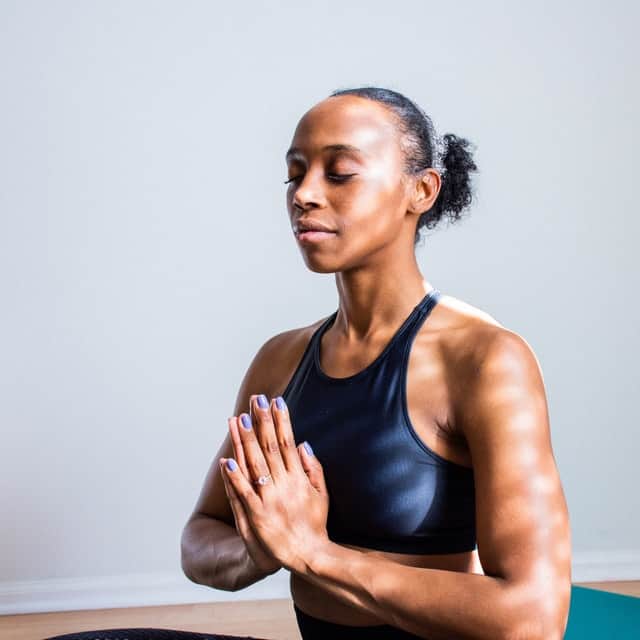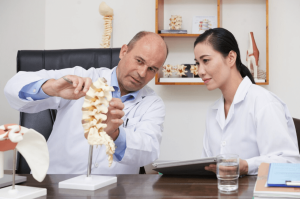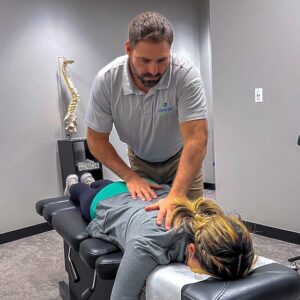Ever wonder why so many people complain of back problems? We can tell you from first-hand experience that one of the main reasons is poor posture.
Most of us as kids never listened when an adult said, “sit up straight” or “stop slouching” and it shows in how we hold our bodies as adults.
Luckily, it’s never too late to change things, to straighten up, and to start achieving better health through having better posture.
What is Good Posture?
Good posture is a standing, sitting, lying, or lifting position that puts the least amount of strain on your musculoskeletal structure. It involves standing/sitting with the back straight, shoulders thrown back, and your weight distributed equally in your body.
It’s about maintaining proper alignment and the natural curve of the spine so that your body can function as nature intended, even while lying down or lifting.
Key Points of Postural Alignment:
- Head stacked directly above shoulders
- Shoulders aligned over hips
- Hips balanced over knees and ankles
- Feet flat on the floor when sitting
- Spine maintains natural curves (cervical, thoracic, lumbar)
The Long-term Health Consequences of Poor Posture
Poor posture can be like a disease. Even though your back will bear the brunt of it, in the long run it affects every aspect of your health.
Spinal disc degeneration is one of the consequences of bad posture. The discs, which are the cushioning material between your spinal vertebrae, start to wear out from the uncomfortable position that people put them through.
For example, hunching over at a computer desk forces your spine to bend unnaturally forwards. Through the years, this position causes an alteration of the natural shape of the spinal discs. The result could lead to a ruptured or dislocated disc, often associated with immense back pain.
An improper lifting position can also cause a herniated disc. Poor lifting techniques cause muscle strains and ligament sprains as well. This is one of the leading causes of occupational back pain.
Other dangers of poor posture include:
- Poor digestion – slouching puts excess pressure on your digestive organs
- Nerve construction – dislocated bones of the back press against the nerves, causing pain and numbness
- Subluxation – parts of your spine and back become misaligned, causing severe pain and even disability
- Blood vessel constriction – results from changes in spinal alignment and can lead to heart conditions
{Read, “How to Make Good Posture a Habit”}
Looking for a Schaumburg Chiropractor or Chiropractor St Charles IL? Those are just 2 of our many Northern Illinois chiropractic offices helping patients with postural issues every day.

The Incredible Benefits of Good Posture
When you change the way you hold your body while sitting, standing, or lifting something, your whole health tends to improve. And that makes sense because proper body structure leads to proper body function. That’s the mantra in chiropractic care and doctors from other fields will tell you the same thing.
Here are 12 of the Top Health Benefits of Having Good Posture:
#1. A Healthier Back
We have already seen this. Proper spinal alignment saves your joints, discs, and muscles from pressure and strain. The result is a better range of motion and increased circulation. Also, you’re less likely to have your spine go out of alignment and start constricting sensitive nerves.
#2. Overall good health
Good posture is a natural solution for many health concerns. You just have to remind yourself to sit straight, stand upright, and lift the right way. When you do that, you sleep better at night, your digestion functions optimally, and your circulation and central nervous systems get to work as expected.
Good posture is, therefore, one of your best allies for better health, better living, and reduced doctor visits.
#3. You look and feel more confident when your back is upright
When they say that you appear more confident when you stand/sit upright, it’s not just psychological gibberish. A study cited by Science Daily shows that, indeed, maintaining an upright posture inspires feelings of confidence in your thoughts.
#4. Respiratory efficiency
A rounded back leads to reduced lung capacity and less oxygen in your blood system. The result is poor performance in physical exercises and potentially other issues like sluggishness and lack of vitality.
On the other hand, good posture helps you breathe freely. Respiratory efficiency is good for metabolism and physical performance.
#5. Stronger back and core muscles
Good posture is a workout. It takes engaging the muscles of the core, back, and chest to manage an upright standing and sitting position. A healthier back and core muscles increase your stability and balance. As a result, you get the ability to move efficiently and perform optimally at work or play.
#6. Improved range of motion
Too much pressure on your flexor, extensor, and oblique muscles make them inflexible. That means in time you will have trouble with movement, sitting, and standing. You can correct that by training yourself to maintain an upright posture.
#7. Fewer headaches
Those recurrent headaches could be stemming from tension in the muscles of the neck and upper back. Good posture can help to rectify that.
#8. You’ll feel less fatigued
Good posture helps you stay energized and productive as your muscles work more efficiently when your bones and joints are in the right positioning. Good posture could, therefore, significantly reduce wasted energy and boost your productivity. Proper positioning and static posture when at rest also supports better sleep by minimizing spinal strain and restlessness at night.

#9. Reduces wear and tear in the joints
Crooked posture accelerates the wear and tear in your hips and knees. Maintaining an upright posture can save you from that pain and help your joints function optimally for many years to come.
#10. Keeps you in good form
Many people would agree that good posture makes you look your best. It also keeps away potentially unattractive issues such as rounded shoulders.
#11. Prevents injuries
When you lift with the right techniques, you spare yourself from muscle sprains and possible bone dislocations.
#12. You feel great
Many people find that standing tall and straight changes the way they feel about themselves. When you stand tall and straight, you radiate confidence and positive energy. In fact, there are studies linking correct posture to reduced stress and improved mood. It’s good for you and those around you.
4 Things You Can Do Right Now to Improve Your Posture
Still not sure if posture is really that important? Try starting these activities right now and see what kind of difference you notice.
Stretch
A simple stretching exercise helps to realign your spinal vertebrae and reduce muscle tension. Try the upper back stretch: Stretch out your hands in front of you then lower your head pressing forward. Chin should be slightly touching the chest. Hold for thirty seconds, raise your head back up and repeat five to ten times.
Take micro-breaks
Have you been sitting or standing since the day started? That can make things very difficult for your back muscles and joints!
Take a 20-minute break to walk around or sit down for a little while. It helps to reduce pressure on your back muscles and joints.
{If you spend a lot of time at a desk, check out, “The Best Way to Sit at Your Desk (And Stay Out of Pain)” by Dr. Casey.}
Set an Ergonomic Workstation
Give your body a setup it actually likes! Adjust your chair so your feet rest flat on the floor, your knees are level with your hips, and your elbows are relaxed at your sides. Raise your monitor to eye level so you’re not constantly bending your neck.
A few quick tweaks now can save you from a lot of neck, back, and shoulder aches later.
Use Posture Apps or Timers
Sometimes we all need a little nudge. Try setting a quick phone alarm or downloading a dynamic posture reminder app to gently prompt you throughout the day.
It’s amazing how much better you’ll feel with just a few mindful check-ins. Small changes really do add up.

Common Posture Problems
Some very common posture issues we see are:
- Hunchback – An excessively curved back that results from sitting in a forward bending position for too long
- Anteriorly tilted pelvis – Your hips tilt forwards because of sitting for extended hours
- Overpronation – Your feet and ankles turn outwards from too much standing
- Forward head jut – The misalignment of head and shoulders that results from slouching
The Chiropractic Approach to Better Posture
Chiropractic Tools for Posture Correction:
- Spinal Adjustments & Subluxation Corrections
- Therapeutic Exercises & Stretches (Physical Therapy)
- Posture Evaluations & Coaching
The Takeaway
Posture affects your health in many ways and the path to a healthy life begins with proper posture. By combing habits aimed at improving posture with regular chiropractic care, you can make a big difference in your overall health and how you feel every day. You could change your health history now by adopting good posture techniques and getting help to reverse any damage done in the past.
Good posture isn’t limited to when you’re awake! Here’s our complete guide to sleeping with perfect posture too.





